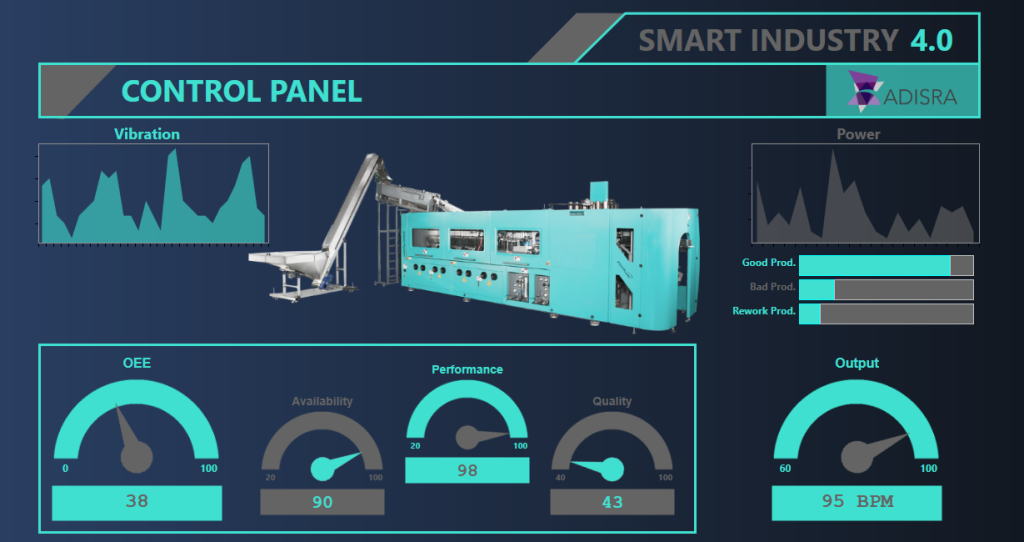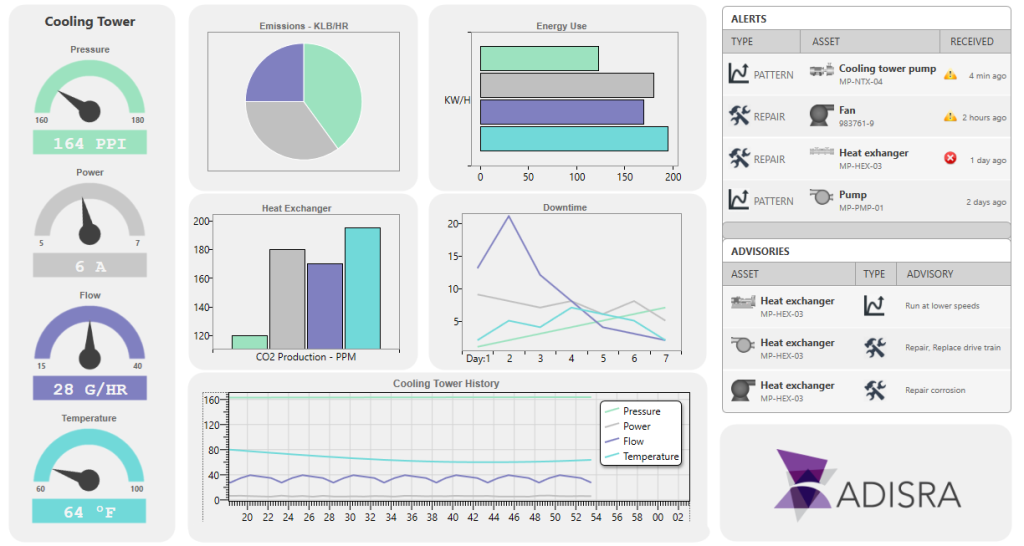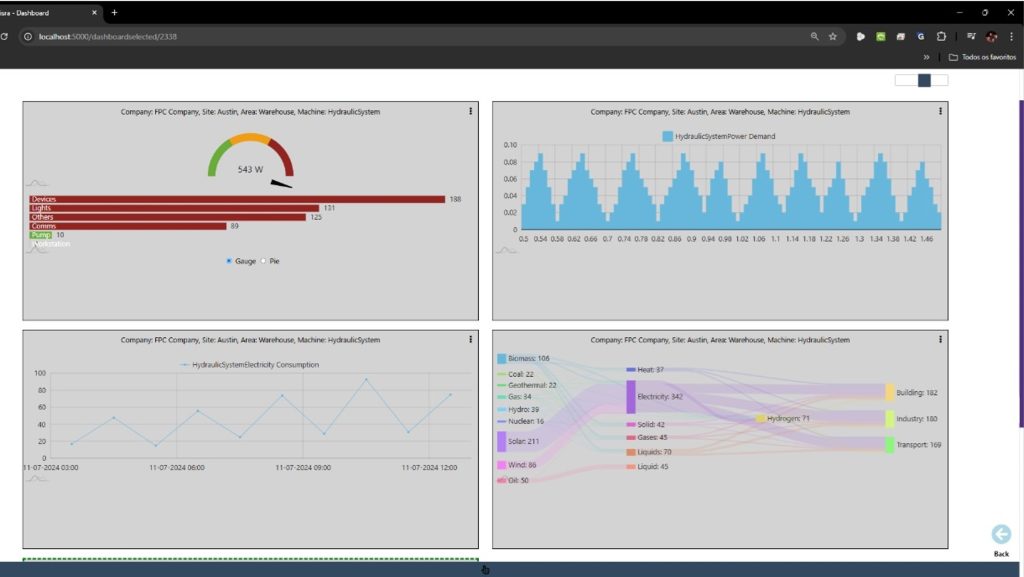
We have seen a significant rise in mid-market manufacturers adopting Overall Equipment Effectiveness (OEE) solutions in the past year. OEE is a key performance indicator (KPI) that measures how effective manufacturing operations are utilized compared to their full potential and provides a clear productive manufacturing time percentage. Given the recent years of constant disruptions—COVID-19, supply chain bottlenecks, and ongoing labor shortages—it’s no surprise that mid-sized manufacturers are prioritizing OEE to build resilience and adapt to uncertainty.
A recent report published in September 2024 by The Business Research Company highlights the impressive growth of the OEE software market, expanding from $58.28 billion in 2023 to $65.70 billion in 2024, a 12.7% compound annual growth rate (CAGR). This growth is largely fueled by a renewed focus on productivity and operational efficiency. For mid-market manufacturers implementing OEE solutions, whether on-premise or in the cloud, this market growth represents a strategic step toward minimizing losses, optimizing resources, and achieving a more resilient and agile manufacturing operation.
Understanding OEE: The Key to Unlocking Manufacturing Potential

“Measurement is the first step that leads to control and eventually to improvement.
If you can’t measure something, you can’t understand it.
If you can’t understand it, you can’t control it.
If you can’t control it, you can’t improve it.”
H. James Harrington
An asset operating with an OEE of 100% runs seamlessly: it produces no defects, experiences zero unplanned downtime, and consistently functions at maximum speed. Although reaching perfect OEE is a tall order, tracking availability, performance, and quality can help keep OEE as close to optimal as possible.
Two Approaches to Calculating OEE
There are two main methods to calculate OEE. The simpler method is the ratio of fully productive time to planned production time over a specific period. Here, fully productive time is defined as the number of quality goods produced, multiplied by the theoretical minimum time required to produce each unit.

This formula represents a helpful calculation of OEE that will indicate if your asset requires maintenance, attention, or decommissioning. However, it will not give you any actionable information about your asset’s quality, availability, or performance.
The preferred way to calculate OEE is mathematically equivalent to the simple formula described above but provides a much richer understanding of waste in the manufacturing process by breaking it down into three factors:
Availability Loss
Performance Loss
Quality Loss
Availability
Availability considers Availability Loss, including all events that stop planned production for significant periods. These include:
Unplanned Stops: Equipment failures, material shortages, etc.
Planned Stops: Changeover times, maintenance, etc.
The formula for Availability is:

where Run Time is defined as:

Performance
Performance measures Performance Loss, reflecting factors that prevent the asset from operating at maximum speed. This factor cannot exceed 100%.
Performance is calculated as follows:

or alternatively:

This factor accounts for equipment speed, minor stops, and idling time.
Quality
Quality measures Quality Loss, factoring out items that do not meet quality standards, including items that require rework. The Quality formula is:

or simply:

This formula calculates Quality as the ratio of units that meet quality standards to the total number of units produced.
Calculating OEE
OEE is the product of Availability, Performance, and Quality:

The resulting percentage indicates overall equipment or process effectiveness, with higher OEE values pointing to more efficient operations and lower values highlighting areas for potential improvement.
Uncovering the Six Major Losses: The Hidden Obstacles to Equipment Efficiency
Originating from Total Productive Maintenance (TPM), the Six Major Losses are designed to categorize productivity losses from an equipment perspective, specifically tailored to discrete manufacturing. Closely aligned with OEE, they offer a detailed and actionable view of where and why OEE losses occur, as illustrated in the chart below.

The Six Major Losses include:
Unplanned Stops are extended periods when equipment is scheduled for production but unexpectedly halted due to unforeseen events, such as equipment breakdowns, tool failures, unplanned maintenance, or shortages in operators or materials. They may also occur when upstream equipment fails to supply materials, or downstream equipment creates a blockage.
Planned Stops are intervals when equipment is scheduled for production but temporarily halted for planned events, such as changeovers, tooling adjustments, cleaning, scheduled maintenance, and quality inspections.
Small Stops are brief interruptions that occur when equipment halts for a short duration, typically a minute or two, and are quickly resolved by the operator. Common causes include misfeeds, material jams, incorrect settings, misaligned or blocked sensors, or minor equipment design issues.
Slow Cycles occur when equipment operates below the ideal cycle time—the theoretical fastest time to produce one piece. Common causes include dirty or worn equipment, inadequate lubrication, low-quality materials, unfavorable environmental conditions, or operator inexperience.
Production Defects are defective parts produced during steady-state production, including those that can be reworked, as OEE measures quality based on First Pass Yield. First Pass Yield (FPY) is a quality metric that measures the percentage of products or parts that are manufactured correctly the first time through the production process, without requiring any rework or adjustments, and is defined as:

Incorrect equipment settings, handling errors by operators or equipment, or issues like lot expiration in industries such as healthcare and food are common causes of production defects.
Startup Defects are defective parts produced from startup until stable production conditions are achieved. Common causes include suboptimal changeovers, equipment requiring “warm-up” cycles, or machines that inherently generate waste during initial startup, such as certain presses.
The Six Major Losses provide added insight that complements and extends OEE, making it easier to pinpoint effective improvement strategies for equipment-related losses.
Maximizing Efficiency with ADISRA: From On-Premise OEE and Predictive Maintenance to Advanced Cloud-Based Analytics

ADISRA SmartView
ADISRA SmartView is a powerful tool for optimizing Overall Equipment Effectiveness (OEE) by providing real-time visibility and control over essential production metrics. Through its intuitive HMI/SCADA interface, operators can monitor the core OEE components—availability, performance, and quality—directly from the plant floor. ADISRA SmartView integrates seamlessly with a variety of equipment and systems, creating a centralized view of production health and efficiency. This enables operators and managers to quickly identify bottlenecks, inefficiencies, and areas for improvement, empowering them to make data-driven decisions that boost productivity and reduce downtime.

ADISRA SmartView
One standout feature of ADISRA SmartView is its built-in rule-based expert system, which automates responses to common production challenges. This intelligent system can detect and react to conditions like equipment slowdowns, quality deviations, or unplanned downtime without requiring manual intervention. For example, if cycle times fall behind, ADISRA SmartView rule-based expert system can automatically initiate corrective actions or alert maintenance teams to prevent further disruption. This proactive approach to OEE management not only minimizes downtime but fosters continuous improvement, ensuring that equipment operates at peak efficiency. The combination of real-time monitoring, advanced analytics, and automation makes ADISRA SmartView an invaluable asset for manufacturers aiming to maximize OEE and maintain resilience and a competitive edge.
Experience ADISRA SmartView by downloading a software trial from our website here.

InsightView (customizable background color)
Complementing ADISRA SmartView, InsightView provides an intuitive tool for analyzing productivity data across machines and processes, covering essential metrics like OEE and the Six Big Losses. InsightView’s customizable dashboards enable users to tailor their monitoring experience to their specific operational needs. Its cloud-based model is designed for mid-market manufacturers and enables advanced analytics and comparative insights across machines, lines, or entire plants. Offered as a software-as-a-service (SaaS) solution, InsightView minimizes IT costs and accelerates time-to-value with minimal configuration. Regular updates are included in the service fee, ensuring users have continuous access to the latest features and enhancements.


InsightView Energy Module (customizable background color)
InsightView also integrates an energy management dashboard, which helps optimize energy efficiency by adjusting machine operating times to match actual demand or scheduling energy-intensive processes during off-peak hours. This reduces operating costs and lowers the carbon footprint, aligning production efficiency with sustainability goals.

KnowledgeView (customizable background color)
Rounding out the suite, KnowledgeView brings predictive maintenance capabilities that enhance production and maintenance efficiency. By focusing on maximizing machine uptime and reducing costly scheduled maintenance, KnowledgeView leverages predictive algorithms to anticipate issues before they arise. This predictive approach minimizes downtime, extends equipment lifespan, and helps manufacturers avoid unplanned disruptions, creating a more resilient and cost-effective operation. KnowledgeView, also offered as a SaaS model, reduces IT costs and provides timely updates as part of the monthly service fee, ensuring continuous improvement and seamless maintenance management for users.
All ADISRA products are accessible not only on desktops and industrial panels but also on mobile devices. This flexibility empowers operators and managers to monitor equipment performance, receive alerts, and access OEE insights and predictive analytics anytime, anywhere—enabling faster decision-making and more responsive operations.
Interested in trying out InsightView and KnowledgeView? Request a temporary account on our website here.
Conclusion
In today’s manufacturing landscape, achieving optimal productivity, efficiency, and resilience is essential for success. ADISRA’s suite of products—ADISAR SmartView, InsightView, InsightView Energy Module, and KnowledgeView—provides a comprehensive, end-to-end solution for improving Overall Equipment Effectiveness (OEE), implementing predictive maintenance, and advancing operational insights, both on-premise and in the cloud. Through real-time monitoring, advanced analytics, and automated responses, ADISRA empowers operators and managers to make data-driven decisions that boost equipment performance and reduce downtime.
ADISRA SmartView gives manufacturers direct visibility into the core OEE components—availability, performance, and quality—right on the plant floor. With its intuitive interface and built-in rule-based expert system, ADISRA SmartView not only helps identify inefficiencies but also automates corrective actions, ensuring production runs smoothly and efficiently.
For enhanced analytics, InsightView allows manufacturers to interpret productivity data across multiple machines, lines, and even facilities. Delivered via a SaaS model, InsightView offers customizable dashboards and seamless cloud integration, minimizing IT costs and providing continuous updates for ongoing improvements. Its energy management dashboard further optimizes resource usage, helping companies reduce both costs and environmental impact.
KnowledgeView complements this ecosystem by offering predictive maintenance tools that help manufacturers anticipate and address potential issues before they disrupt production. By maximizing machine uptime and minimizing unplanned outages, KnowledgeView promotes a resilient and cost-effective operation.
Together, ADISRA’s solutions bring actionable intelligence to every level of the enterprise, allowing manufacturers to monitor performance, receive alerts, and access OEE and predictive analytics on any device. This flexibility ensures operators and managers are empowered to respond quickly to production challenges, whether they are on the plant floor or on the go. ADISRA’s innovative, adaptable approach to OEE and operational management positions manufacturers to maintain a competitive edge and build long-term resilience in an increasingly dynamic market.
ADISRA®, ADISRA’s logo, InsightView® and KnowledgeView® are registered trademarks of ADISRA, LLC
ID 110225300 © Lancelotlachartre | Dreamstime.com, ID 110225300 © Lancelotlachartre | Dreamstime.com
